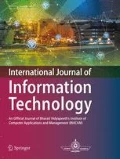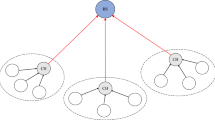Abstract
To reduce energy consumption, nodes in ad hoc networks generally move according to a pre-established schedule of network traffic and movement patterns of uplink and downlink neighbors. While some of them may go to sleep at times, one suitable alternative is to remain in active mode in order to bridge the gap between the uplink and downlink neighbors of the sleeping node. The main challenge of selecting which node should stay in active mode and which node should go to sleep, stem from the need to conserve energy while maintaining communication. Proactive topology management protocols identify redundant nodes that may power off the radios. Such protocols are independent of network traffic and incur backbone maintenance cost even when the network is idle. MGMT is a movement guided topology management scheme that suggests movements of nodes so that, for a given communication link, transmitter and receiver may come closer without hampering their links with other nodes i.e. respective uplink and downlink neighbors. Moreover, MGMT works based on the schedule in which packets are forwarded to the downlink neighbors of a node. It is energy efficient in the sense that it always concentrates on gaining radio-frequency energy at the cost of some kinetic energy which is at most half of the gained radio-frequency energy. Through extensive simulation, we demonstrate that MGMT achieves huge energy conservation while maintaining efficient communication.








Similar content being viewed by others
References
Feeney LM, Nilson M (2001) Investigating the energy consumption of a wireless network interface in an ad hoc networking environment. In: IEEE INFOCOM
Kravets R, Krishnan P (2000) Application-driven power management for mobile communication. Wireless Netw 6(4):263–277
Xu Y, Heidemann J, Estrin D (2001) Geography-informed energy conservation for ad hoc routing. In: 7th annual international conference on mobile computing and networking (MobiCom)
Zheng R, Kravets R (2003) On-demand power management for ad hoc networks. In: IEEE INFOCOM
Singh S, Raghavendra C (1998) PAMAS: power-aware multi-access protocol with signalling for ad hoc networks. ACM Comput Commun Rev 28(3):5–26
IEEE 802 LAN/MAN Standards Committee (1999) Wireless LAN medium access control (MAC) and physical layer (PHY) specifications. IEEE Stand 802:11
Mehta R, Lobiyal DK (2017) Utility based performance analysis of cross layer design in multi-flow ad hoc networks. Int J Inf Technol 9(4):377–387
Arora B, Nipur (2014) Stable ad hoc on demand multipath distance vector—SAOMDV. Int J Inf Technol 6(2):779–782
Rana K, Tripathi S, Raw RS (2016) VANET: expected delay analysis for location aided routing protocol. Int J Inf Technol 8(2)1029–1037
Zheng R, Hou JC, Sha L (2003) Asynchronous wakeup for ad hoc networks. In: 4th ACM international symposium on mobile ad hoc networking and computing (MobiHoc)
Chiasserini CF, Rao RR (2001) Combining paging with dynamic power management. In: IEEE INFOCOM
Chen B, Jamieson K, Balakrishnan H, Morris R (2001) Span: an energy-efficient coordination algorithm for topology maintenance in ad hoc wireless networks. In: 7th annual international conference on mobile computing and networking (MobiCom)
Zhu Y, Moheimani OR (2010) Ultrasonic energy transmission and conversion using a 2-D MEMS resonator. IEEE Electron Device Lett 31:4
Sinha P, Sivakumar R, Bharghavan V (2001) Enhancing ad hoc routing with dynamic virtual infrastructures. In: IEEE INFOCOM
Wu J, Li H (1999) On calculating dominating set for efficient routing in ad hoc wireless networks. In: Workshop on discrete algorithms and methods for MOBILE computing and communications
Wu J, Dai F, Gao M, Stojmenovic I (2002) On calculating power-aware connected dominating sets for efficient routing in ad hoc wireless networks. KICS J Commun Netw 4(1):59–70
Bao L, Garcia-Luna-Aceves JJ (2003) Topology management in ad hoc networks. In: 4th ACM international symposium on mobile ad hoc networking and computing (MobiHoc)
Cerpa A, Estrin D (2002) ASCENT: adaptive self-configuring sensor networks topologies. In: IEEE INFOCOM
Gautam DR, Sharma S, Sahu S (2011) Enhanced transmission power control mechanism based on RSSI for MANET. Int J Comput Appl 28:1
Shahana S, Yuvarani S, Gowtham MS (2016) Energy-efficient routing design for ad hoc networks using cross-layer. Int Conf Syst Sci Control Commun Eng Technol 2:456–460
Upadhyaya J, Manjhi N (2016) A survey—energy efficient routing protocols in MANET. Int J Future Gener Commun Netw 9(5):163–168
Banerjee A (2016) Sensor networks summarized. Lambert Academic Publishing, Saarbrücken
Banerjee A, Dutta P (2010) Fuzzy controlled adaptive and intelligent route (FAIR) selection in mobile ad hoc networks. Eur J Sci Res 45:3
Jamali S, Rezaei L, Gudakahriz SJ (2013) An energy efficient routing protocol for MANETs: a particle swarm optimization approach. J Appl Res Technol (Elsevier) 11(6):803–812
Author information
Authors and Affiliations
Corresponding author
Rights and permissions
About this article
Cite this article
Banerjee, A., Dutta, P. & Sufian, A. Movement guided management of topology (MGMT) with balanced load in mobile ad hoc networks. Int. j. inf. tecnol. 11, 149–158 (2019). https://doi.org/10.1007/s41870-018-0143-y
Received:
Accepted:
Published:
Issue Date:
DOI: https://doi.org/10.1007/s41870-018-0143-y




